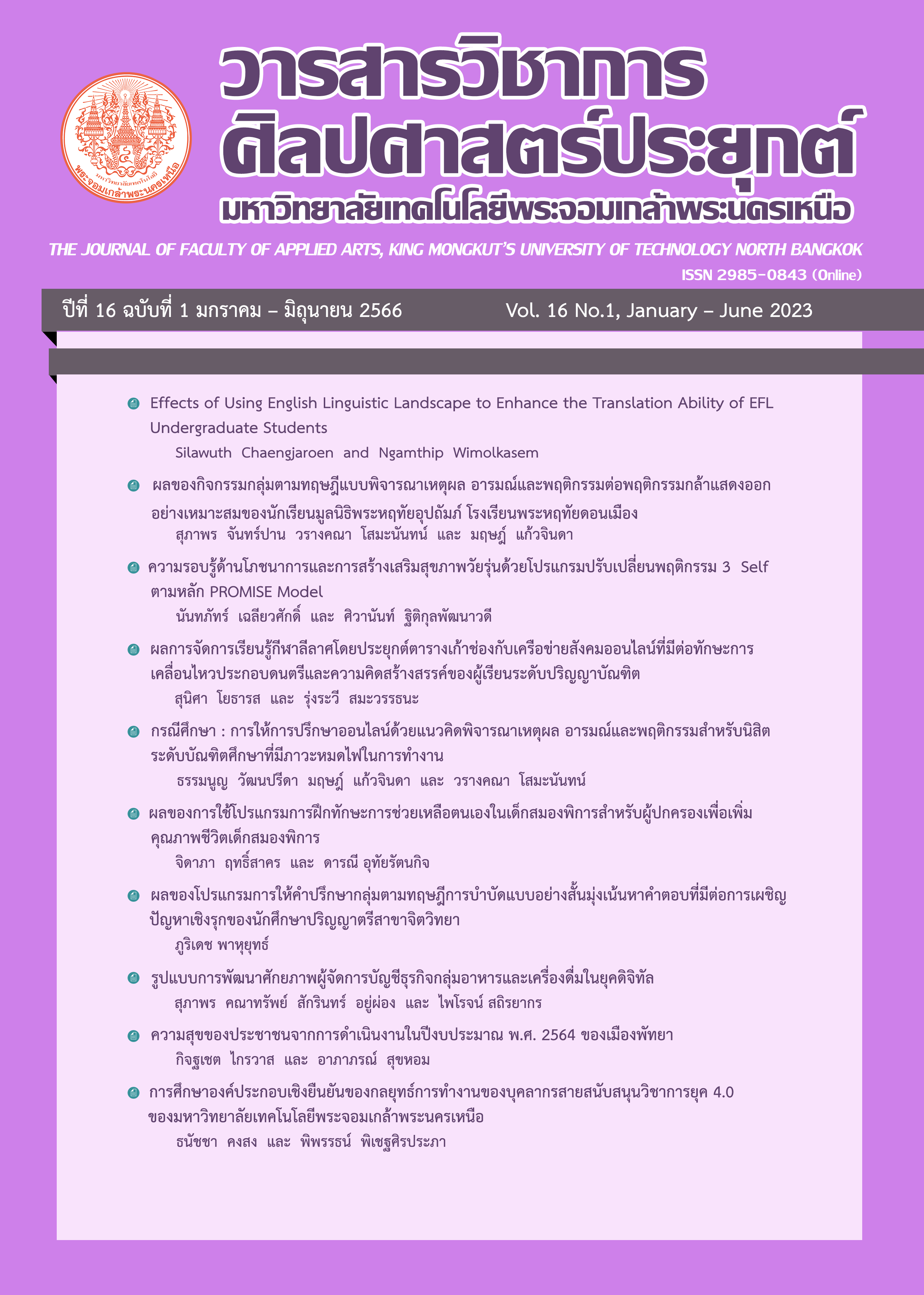ผลของการใช้ภูมิทัศน์ภาษาศาสตร์ภาษาอังกฤษเพื่อเพิ่มเสริมสร้างความสามารถด้านการแปลของนักศึกษาที่เรียนภาษาอังกฤษเป็นภาษาต่างประเทศในระดับปริญญาตรี
Main Article Content
บทคัดย่อ
การวิจัยครั้งนี้มีวัตถุประสงค์เพื่อศึกษาผลของการใช้ภูมิทัศน์ภาษาศาสตร์ต่อความสามารถด้านการแปลของนักศึกษา ผู้วิจัยได้ใช้ทฤษฎีกล้องถ่ายรูปภาคสนาม (Camera Safari) ในการเก็บข้อมูลภูมิทัศน์ภาษาศาสตร์ในย่านธุรกิจของกรุงเทพมหานคร จากนั้นจึงนำข้อมูลที่ได้มาวิเคราะห์และจัดทำบทเรียนสำหรับนักศึกษาในรายวิชาการแปล ปีการศึกษา 2564 ณ มหาวิทยาลัยหัวเฉียวเฉลิมพระเกียรติ ผู้วิจัยได้ประยุกต์ทฤษฎีของ อัลกรันนี และซีริน (2564) โดยใช้แบบทดสอบก่อนและหลังการเรียนรู้ (Pre-Post-test) เพื่อดูผลการพัฒนาจากคะแนนการแปลที่นักศึกษาได้ทำการทดสอบ พร้อมทั้งเก็บข้อมูลความคิดเห็นเชิงคุณภาพจากการสัมภาษณ์นักศึกษาและวิเคราะห์ข้อมูลเชิงสถิติโดยใช้ ค่าเฉลี่ย ค่าเบี่ยงเบนมาตรฐาน และการทดสอบที (T-test) ซึ่งผลการวิจัยพบว่าในการทดสอบก่อนการเรียน คะแนนเฉลี่ยของนักศึกษาอยู่ที่ 31.88 ในขณะที่คะแนนการทดสอบหลังการเรียนเพิ่มขึ้นเป็น 38.02 ซึ่งแสดงความแตกต่างที่มีนัยสำคัญทางสถิติที่ 0.00 นอกจากนี้ ผลการวิจัยจากการสัมภาษณ์สรุปได้ว่า ภูมิทัศน์ภาษาศาสตร์เป็นแหล่งความรู้ที่มีศักยภาพในการพัฒนาความสามารถด้านการแปล การตระหนักรู้ทางภาษา ทักษะการคิดอย่างมีวิจารณญาณ และเป็นแรงจูงใจในการเรียนรู้ของนักเรียน การศึกษานี้ได้แสดงให้เห็นถึงมุมมองใหม่ ๆ และข้อดีของการใช้ภูมิทัศน์ภาษาศาสตร์เพื่อส่งเสริมการเรียนรู้ของนักศึกษาที่ใช้ภาษาอังกฤษเป็นภาษาต่างประเทศ
Article Details

อนุญาตภายใต้เงื่อนไข Creative Commons Attribution-NonCommercial-NoDerivatives 4.0 International License.
1.บทความที่ตีพิมพ์เป็นลิขสิทธิ์ของวารสารวิชาการศิลปศาสตร์ประยุกต์ การนำเนื้อหา ข้อความหรือข้อคิดเห็น รูปภาพ ตาราง ของบทความไปจัดพิมพ์เผยแพร่ในรูปแบบ ต่าง ๆ เพื่อใช้ประโยชน์ในเชิงพาณิชย์ ต้องได้รับอนุญาตจากกองบรรณาธิการวารสารอย่างเป็นลายลักษณ์อักษร
2.ข้อความที่ปรากฏในบทความแต่ละเรื่อง เป็นความคิดเห็นส่วนตัวของผู้เขียนแต่ละท่านไม่เกี่ยวข้องกับวารสารวิชาการศิลปศาสตร์ประยุกต์ และบุคลากร คณาจารย์ท่านอื่น ๆ ในวารสารฯ แต่อย่างใด ความรับผิดชอบองค์ประกอบทั้งหมดของบทความแต่ละเรื่องเป็นของผู้เขียนแต่ละท่าน หากมีความผิดพลาดใด ๆ ผู้เขียนแต่ละท่านจะรับผิดชอบบทความของตนเองแต่ผู้เดียว
เอกสารอ้างอิง
Algryani, A. & Syahrin, S. (2021). Utilizing Learners’ Linguistic Landscape as a Pedagogical Resource in the Translation Classroom: A case study in the Sultanate of Oman. Arab World English Journal (AWEJ), Volume 12: 357-373.
Cenoz, J. & Gorter, D. (2013). Towards a plurilingual approach in English language teaching : Softening the boundaries between languages. TESOL Quarterly, 47(3): 591-599.
Clemente, M., Andrade, A. I., Martins, F., Hélot, C., Barni, M., Janssens, R., & Bagna, C. (2012). Learning to read the world, learning to look at the linguistic landscape: A primary school study. Linguistic landscapes, multilingualism, and social change, p. 267-285, Frankfurt, Germany: Peter Lang.
De Pedro, Ricoy. (1996). Beyond the words: The translation of adverse. Babel, 42(1) : 27-45.
Fan, H. (2017). Strategies for translation of English commercial advertisement from the intercultural perspective. Open journal of social sciences, 5(11) : 38-45.
Hancock, A. (2012). Capturing the linguistic landscape of Edinburgh : A pedagogical tool to investigate student teachers’understandings of cultural and linguistic diversity. Linguistic landscapes, multilingualism and social change, p. 249-266.
Hewitt-Bradshaw, I. (2014). Linguistic landscape as a language learning and literacy resource in Caribbean Creole contexts, Caribbean Curriculum, 22, p. 157-73.
Khanmohammed, H. & Osanloo, M. (2009). Moving towards objective scoring: A rubric for translation assessment. Journal of English language study. Vol.1 No.1: 131-153.
Kuşçu, S. & Ünlü, S. (2015). Teaching translation: A suggested lesson plan on translation of advertising through the use of authentic materials. Procedia-Social and Behavioral Sciences. 199: 407-414.
Landry, R. & Bourhis, R. Y. (1997). Linguistic landscape and ethnolinguistic vitality: An empirical study. Journal of language and social psychology, 16(1): 23-49.
Lazdina, S. & Marten, H. F. (2008). The “linguistic landscape” method as a tool in research and education of multilingualism. Experiences from a Project in the Baltic States. In Multilingualism : Proceedings of the 23rd Scandinavian Conference of Linguistics, Uppsala University, 1-3.
Nord, C. (1991). Text analysis in translation : Theory, methodology, and didactic application of a model for translation-oriented text analysis, Rodopl, Amsterdam.
Rowland, L. (2013). The pedagogical benefits of a linguistic landscape project in Japan. International Journal of Bilingual Education and Bilingualism, 16(4) : 494-505.
Sayer, P. (2010). Using the linguistic landscape as a pedagogical resource. ELT journal, 64(2) : 143-154.
Thongtong, T. (2016). A linguistic landscape study of signage on Nimmanhemin road, A Lanna Chiang Mai chill-out Street. MANUSYA : Journal of Humanities, 19(3): 72-87.
Shohamy, E. & Waksman, S. (2009c). Linguistic landscape as an ecological arena : Modalities, meanings, negotiations, education. In E. Shohamy & D. Gorter (Eds.), Linguistic Landscape : Expanding the Scenery, p. 313-331. New York: Routledge.
Velasco, J. A. P., Sánchez, M. T., & Rodríguez, C. I. L. (2007). Using Multimedia Materials in the Teaching of Scientific and Technical Translation. Linguistica Antverpiensia, New Series–Themes in Translation Studies, (6): 111-134.


